 "I Am Jack's Younger Self":
"I Am Jack's Younger Self": 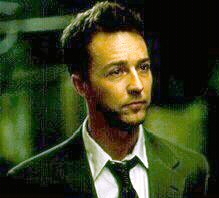
 "I Am Jack's Younger Self":
"I Am Jack's Younger Self": 
The Secret Connections between "Fight Club" and "Calvin and Hobbes" REVEALED!
By Galvin P. Chowhttp://ignatz.brinkster.net/cfightclub.html
In the movie Fight Club, the real name of the protagonist (Ed Norton's character) is never revealed. And while some feel the only reason behind this is to give the character more of an "everyman" quality, I say, do not be deceived. Because it's obvious to anyone with working eyes that "Jack" is actually someone whom many of us grew up with, someone who might've been present at all your childhood breakfasts of Sugar Frosted Chocolate Bombs. You see, "Jack" from Fight Club and Calvin from the greatest comic strip ever, "Calvin and Hobbes," are in fact the exact same person! You have doubts, I'm sure. Well, that's to be expected. But laugh now, for by the time you finish reading this page, I will prove to you beyond a shadow of a doubt that Ed Norton is indeed playing the part of grown-up Calvin.
Part I: The Hobbes-Tyler Connection
We start with the most obvious bit.Picture this: a hyper, self-absorbed child initially concocts an imaginary friend as the ideal playmate, to whom more realistic qualities soon become attributed. This phantasm becomes a completely separate personality, with his own likes, dislikes, temperament -- and the imaginer and the imagined clash and argue constantly, though remaining fast friends. This pattern continues to the point where the child begins to perceive what was originally mere fantasy to be _reality_. So, in short...
...Calvin has an imaginary jungle-animal friend named Hobbes, whom everyone else believes to be nothing but a stuffed toy...

"There are EIGHT rules of Fight Club!"
 ...just as Tyler is Jack's imaginary cool-guy friend, whom no one but Jack can see.
...just as Tyler is Jack's imaginary cool-guy friend, whom no one but Jack can see.
"Mmm, fresh swordfish steaks!"
Now then, filling in the time-gap between Calvin and Jack, we can imagine the story as something like this: Once Calvin reaches the hostile environment known as the 7th grade, the constant teasing from the other students and the frustrated concern of his parents finally becomes too much, and a reluctant, disillusioned Calvin is finally forced to grow up, or at least begin to. This decision is sealed by one of the hardest things young Calvin will ever have to do in his life -- un-imagining Hobbes, an act which to Calvin is essentially no different from murder. After being Calvin's best friend for over a decade, Hobbes is packed away in a box, or tossed carelessly into a garbage bag, perhaps even stuffed under the same bed that once contained so many monsters. This is all of course, very painful for Calvin, so much so that he represses it all in shame. So little did Calvin suspect, that while he was busy learning to tie ties, asking someone out to his first dance, deciding what "dinette set defines him as a person," and basically growing up, Hobbes is in fact doing the same thing, in a dark, hidden corner of Calvin's mind, waiting for the moment when he can be free again.
It's worth noting that during these 20 or so years, Hobbes never bore a grudge against Calvin nor wished any ill upon him. Back in their prime, though they bickered constantly, the pair truly did deeply care for each other. And Hobbes, knowing this, resents being put away, but he does not hate Calvin. Rather, he hates the society that MADE Calvin put him away. Hobbes, being inside Calvin's mind, sees and experiences all that Calvin does -- and truly despises all of it. He witnesses a bright, superbly imaginative kid (with a genius-level vocabulary, I might add) reduced to nothing more than another nameless cog, and fighting off the tears wept for his best friend, resolves to one day set him free. And perhaps pays special attention when a bored, college freshman Calvin idly looks up homemade-napalm recipes on the internet, wistfully fantasizing about the freedom he traded in all for the sake of "growing up"...
Flash forward to the timeframe depicted in "Fight Club." Jack, or should I say, "Rupert," or "Cornelius" has reached an all-time low. Even though he had done everything he was supposed to have done, and wound up completely miserable. Which is when Hobbes, newly adjusted as "Tyler Durden" (after all, grown-up Calvin would no longer accept a jungle animal walking, talking, and eating canned tuna), re-enters Calvin/Jack's life. He's going to show Calvin everything he's done wrong, whether Calvin likes it or not.
Tyler to Jack: "I look like you wanna look, I fuck like you wanna fuck, I'm smart, capable, and most importantly, I'm free in all the ways you wish you could be." And to anyone who argues that Calvin never secretly idolized Hobbes, I point you towards the storyline wherein Calvin dresses up like a tiger and attempts to live in the woods, as collected in "Weirdos From Outer Space!" Moreover, Hobbes was always smarter than Calvin, often served as his social conscience -- yet was not above mischief, often because he knew Calvin would be the only one taking the blame. Both Hobbes and Tyler are cool, collected, intelligent and very cerebral, and share a distaste for man's self-importance, as shown in the panel below:
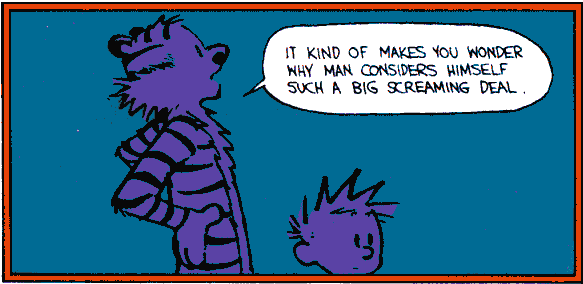
"You are NOT a beautiful and unique snowflake"...early signs of Tyler?
Want further proof? Look at Tyler's relationship with the only woman in Jack's life: Marla.
Part II: Marla Singer: Avatar of Susie Derkins?
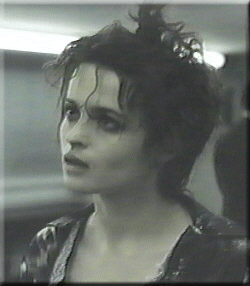 =
=
 ?
?
Dual Victims of Testicular Cancer?
Okay, I know what you're thinking."All right," you say, "Calvin being Jack is a stretch, Hobbes being Tyler is even more of a stretch, but Susie being Marla? Simply impossible! For one thing, their personalities are nothing alike, and also, Marla is not imaginary nor does she remain unnamed throughout the film!"
To which I respond, oh ye, of little faith. Imagine, please, the following:
Somewhere between the end of high school and beginning of college, uptight, grade-obsessed Susie Derkins loses her way. The pressure to get good grades, the pressure to succeed, simply becomes too much for her, and she snaps. Free from the protective bonds of her parents' guidance and the bland safety of her suburban home, she loses her moral bearings entirely and sinks into a dark, seamy, grim world of sex, drugs, and eccentric Albert-Einstein-like hair. And, her transformation being so complete that she no longer even remotely resembles the upright citizen that her parents and society, not necessarily she herself, wanted her to be, she also changes her name. Like Calvin, she has become a misfit, one of society's lost lambs. It is for this reason that she soon finds herself frequenting support groups such as "Remaining Men Together." Fate has brought her back to Calvin, whom maybe she even spurned back in junior high. But the two have changed so much that they no longer recognize each other!
Also I'd like to point out that the pink dress Marla wears in one scene slightly resembles something that "Binky Betsy," Susie's favorite childhood doll, might wear. You remember, the one Calvin once stole and attempted to ransom, but...oh never mind.
All right, so it's a BIT of a stretch, but it could happen! And regardless of whether Marla is indeed the twisted, fallen-from-grace future of Susie "Straight-and-Narrow" Derkins, the fact remains that the two girls play similar roles in the lives of their respective male counterparts, AND with their imaginary friends. Which is to say, that while Calvin and Susie mostly teased and tortured each other, HOBBES, on the other hand, actually quite fancied the raven-haired beauty. Accordingly, Jack despises Marla, whereas Tyler takes an *ahem* sort of interest in her that is definitely NOT appropriate for the Sunday Funnies. And it is through the examination of these relationships in which we can find further evidence that "Jack" is the matured Calvin.
When first we are introduced to Marla, she is but a tumor on Jack's slowly deteriorating world. She is disenfranchised, morbid, socially apathetic -- and Jack despises her because she is a mirror image of himself, his own female double. On the other hand, Calvin hates Susie because she is his exact opposite: Bright, obedient, demure -- the unruly Calvin has every reason to hate her. However, certain strips definitely infer that Calvin has somewhat of a crush on Susie, and some even imply that Susie shares these latent feelings. But as a cootie-fearing grade-schooler, Calvin may only express these strange feelings through attention-getting antagonisms such as constant snowballs to the head, ransoming her dolls -- AND through his separate, conveniently more mature other personality -- Hobbes.

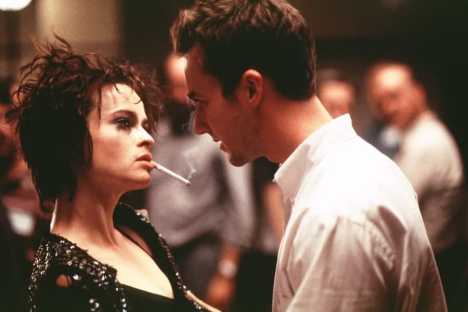


Above: The grown-up versions of Calvin, Hobbes, and Susie restart their old relationships.
Unlike Calvin, Hobbes has never been bashful about showing his
affection for Susie. Calvin's imaginary tiger-friend has called her a
"cutie,"
worn swim jams to impress her ("Girls flip for guys in jams"), and even
claimed he would betray their club's secret code if
she gave him a tummy rub (which is one of the key differences between
Tyler and Hobbes). Naturally,
all of this confuses and frustrates Calvin beyond words, even
though Hobbes is really nothing more than a product of his own mind!
And though Hobbes and Susie never consummated their
love for each other (he's a stuffed tiger and she's a kid, you sicko!)
this is, of course, the EXACT same deranged love-triangle
that is shared between Jack, Tyler, and Marla, or at least a natural
progression thereof. Perhaps Marla puts up with Jack/Tyler's
apparent nonsense for so long, because it's the sort of thing she became
used to as a child? And perhaps, in the end, Jack
finds solace in Marla because it's the exact same connection he
should've made long ago, in his suburban youth. A connection
that may have saved them both.A minor loophole here is Marla's line, "I haven't been fucked like that since grade-school." Well, besides that line having been substituted by David Fincher, not the writer, for another ("I want to have your abortion"), it's more than likely Marla was simply exaggerating, or even considers "Susie" to have never existed.
Part III: GROSS: Precursor of Fight Club
A lot of people think that the creation of something like "Fight Club," by which I mean the actual club and not the movie, would be a frighteningly revolutionary thing. But this is not so. Because when you boil it down, the fighting-club that Jack and Tyler start is really just an odd sort of boys' club -- no ovaries allowed -- where men can be men, and the so-called stronger of the sexes can take solace in the fact that, even in our politically correct times, some exclusivities of manhood still remain. (As a side note, imagine how much more controversy the movie would have generated if it involved scenes of men fighting women on equal ground!) And clubs like this, of course, have their beginnings in backyards, tree houses and garages all over America. Clubs where boys can be boys, clubs made just to exclude girls. And, not surprisingly, Calvin, and Hobbes, started such a club when he was 6 years old. Little did anyone realize that he would construct another one much later in his life, again with the aid of an imaginary friend. For just as Calvin, Hobbes, and Susie have dark future versions in Jack, Tyler, and Marla respectively, GROSS -- Get Rid of Slimy girlS -- has the same in Fight Club.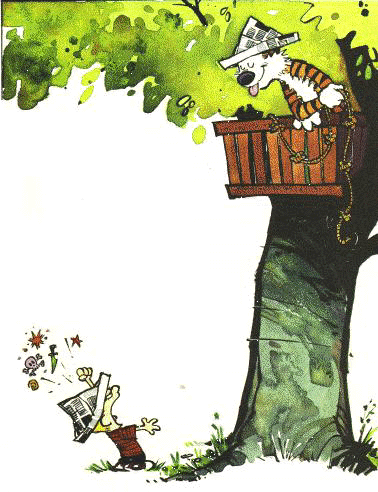
Above: In a scene eerily reminiscent of Fight Club, Hobbes blithely informs a
sulking Calvin that he decides his own level of involvement in GROSS.
GROSS shares many characteristics with Fight Club. Among them:
- Both have catchy names (although the "slimy" part of GROSS is redundant, otherwise it doesn't spell anything).
- Both are co-run by a friendless male and his imaginary companion (Calvin is Tyrant and Dictator-for-Life; Hobbes is President and First Tiger).
- Both are exclusively male organizations, although Fight Club's membership is considerably larger.
- Along with that, all members of both organizations are very loyal
- The leaders of both organizations constantly engage in fisticuffs (but only in GROSS does a member receive a demerit for biting)
- And in said fights, in both organizations there is only one fight at a time!
- Both are supposedly very secretive (though Jack never tells his mother about Fight Club)
- At least one leader of both organizations is fond of giving speeches (though Calvin never uses the term "space monkey")
- GROSS and Fight Club both wreak havoc on their respective neighborhoods (GROSS' target is considerably more focused, i.e., Susie)
Part IV: Moe Develops Karmic Bitch-Tits
 ---Atonement--->
---Atonement--->
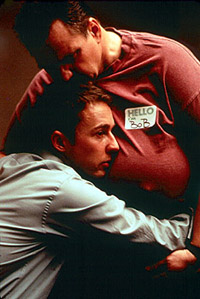
But *coughcough* Chloe is actually Calvin's old babysitter Rosalyn. Seriously. The evidence is all there, but no one believes me. Fools, all of you!
Part V: The Root of Evil
Although we've already learned of the fates of Hobbes, Susie, and even Moe and Rosalyn (sort of...), there are a couple of other people important to Calvin that are missing. People that even more integral to his development than (arguably) Hobbes. And these people, are of course, his parents. Namely... His father, Mr...uhm...
His father, Mr...uhm... ...and his mom, otherwise known as...uh...gimme a sec here...
...and his mom, otherwise known as...uh...gimme a sec here...We'll begin with Calvin's mom, since she seems the less consequential. In the strip, she appears to be an ordinary housewife, nothing more, nothing less. She comforts or scolds Calvin as needed, goes to many parent-teacher meetings, and seems to enjoy gardening, and that's about all we know. She doesn't seem to be a particularly weak woman, as she seems on fairly equal ground with her husband, in terms of intelligence and personality. Nevertheless, locked in the passive role of a housewife, she appears to have had relatively little effect on Calvin's development.
Now Calvin's dad, on the other hand, seems to have done quite a number on his son. As stated, it was probably at his urging that Calvin "grew up," by which I mean, finally started to try and play by society's rules, which is something that we know never quite worked out. Of course, he wasn't without his playful side -- good-naturedly teasing Calvin at every opportunity -- but perhaps this is why Jack resents him so. For maybe, after Jack reached the end of the path of that was decided for him, only to find emptiness as his reward, perhaps he thought back to when his father told him that the sun sets down somewhere in Arizona every night. "Maybe," thought Calvin, "maybe ALL of it's been just another one of Dad's cruel jokes."
In the "bathtub" scene of Fight Club, Jack and Tyler discuss their parents. In this scene, key information arises, as do, apparently, large inconsistencies. First the latter. Jack claims his father left when he was six, an age when Calvin's was obviously still around, but this statement is contradicted soon after, when Tyler mentions his own dad telling him to get married when he was 30, to which Jack responds, "mine said that TOO." So what this probably amounts to is the self-pitying Jack attempting to garner additional sympathy from his newfound friend by making his childhood sound worse than it actually was. But even more interesting is Tyler's hostility towards his father: when Jack asks him who he would fight, if he could fight anyone, he answers, "I'd fight my father." But, since Tyler is only a figment of Jack's imagination, we can only assume he's referring to JACK'S father. And while this hatred would only make sense given that the two are sharing the same brain, why is it that Tyler seems to hate Jack's father even more vividly than Jack himself does? Well, maybe it's because Tyler hasn't forgotten who's ultimately responsible for the de-imagining that took place years before...maybe he's still not too happy about it...
 ...and maybe he's got some pretty good ideas for revenge.
...and maybe he's got some pretty good ideas for revenge.
Calvin.
Part VI: And Finally: "I Am Jack's Lost Youth -- Calvin"
As we've already thoroughly examined all the secondary members of the cast, and analyzed them in light of their various relationships with the protagonist, actually putting Calvin himself under the microscope, at this point, seems largely unnecessary. After all, there already seems to be abundant evidence of the connections between Fight Club and Calvin and Hobbes. However, there do remain some key points that rest only within Calvin, and only with Calvin, himself. So, examine we shall.Although the personality differences between Calvin in the comic strip and Calvin in the movie are pretty large, it can be explained as easily as taking Id and introducing him to Superego (Jack actually seems to have sort of a Super-Superego). Nearly all people go through the same thing when first confronted with the crushing grind of reality. But, as they say, the bigger they are, the harder they fall -- and in terms of imagination and dreams, Calvin was a giant.

Above: Calvin displaying an early distaste for institution
Still, it's not as though no common traits between Calvin-Calvin and Jack-Calvin can be identified at all. Besides a
preference for imaginary friends over real ones, and an ability to express affection for girls, Calvin has never done well
when forced to play by any sort of rules. Take, for instance, his utter inability in any sort of organized sport, compared
to his unbridled joy while playing the make-it-up-as-you-go-along "Calvinball." Furthermore,
even at age 8 Calvin never exactly thrived in stifling, authoritarian establishments (i.e., school), and he's always had
clashes with authority figures since the strip began (his parents, the doctor, his teacher, Rosalyn) -- which actually may
have initially planted the seeds for Tyler. Beyond that, his excellent vocabulary and way with words is still with him in the
voice-over narration of Fight Club, and the rampant materialism that started with mail-order propeller-beanies ended
with yin-yang shaped tables. I'm sure I'm even forgetting a few of the similarities -- as for the differences, they can be
credited to the demoralizing effect of reality.Of course, there IS the issue of Calvin's trademark spiky blond hair, noticeably absent on Jack. But, many adult brunettes were blondes as children, and furthermore, notice how Tyler, Jack's image of an ideal male, does possess the hairstyle in question.
So, when it all comes down to it, what do the events of Fight Club mean to Calvin? Two words: "Personal Responsibility." For although Fight Club and Project Mayhem were both mostly Tyler's doing, by the end of the movie, Jack readily accepts his own part of the blame, as Tyler is his creation. And by doing so, he's also accepting responsibility for the undesirable condition of his own LIFE -- his father may have pushed him, but Calvin himself was the one who chose to obey. It is through this newfound self-accountability that Calvin/Jack is able to take control of his own life at last. As skyscrapers flash and crumble in the background, and blood oozes from the bullet hole in his head, Calvin says that he is "okay." And we are apt to believe him.
Part VI: Odds, Odds, and Ends
Despite my exhaustive research, there are still some oddities and disparities along the way from Calvin to Jack. None of them are too important, so I'll just list them briefly:- Whither Calvin's trademark red, black-striped shirt? If he's attempting to revert more back to his old self, you'd think he woulda tracked down something similar, as his "Rosebud."
- It's hard to believe Calvin could ever really get along without TV.
- Notice how Calvin and Hobbes actually reversed many personality traits as Jack and Tyler? Maybe Calvin is the personality that got repressed and Hobbes is the one that did the "growing up."
- Tyler wears a fur coat near the end of the movie. What is the significance of this garment, given his past incarnation as a jungle animal? Discuss.
- Jack's skill with firearms apparently was not helped by years of practice on Calvin's dart gun.
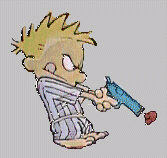
"Stay away from me, Tyler!"
- If Calvin really wanted to change things, then why didn't he just dust off his old cardboard-box time machine and hop in?
- Given Calvin's dislike for camping trips as a child, it's strange he took to life in the Paper Street house so easily.
- Tyler has a preference for loud, gaudy clothing, whereas Hobbes' look was always one of dignified reserve.
- If it had been winter in the movie, I'm sure there would have been a scene where Jack and Tyler make a small gallery of gruesome snowmen.
- After the end of Fight Club, when Calvin realizes he's effectively killed Hobbes twice now, do you really think he'll still be "okay"?
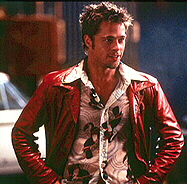 Tyler Durden says: "You've read this far, you may as well finish it!"
Tyler Durden says: "You've read this far, you may as well finish it!"Part VII: Conclusion
*Whew* That was quite a trip, wasn't it? We've come a long way, and you're probably more than a little confused. So, let's finish off with some brief explication.To look at it one way, Calvin's world in the comic strip is pure, romanticized idealism, whereas in the movie, he lives in gray, bleak reality. Within the safety of the panel, Calvin is perpetually eight years old, terrible things can never happen, and no matter how crazy a stunt he pulls, everything always returns to status quo. Because of this, our hero is free to do as he wishes, free to chase his dreams as wildly as he desires, never having to worry about tomorrow because there essentially will never BE one -- unless it's part of a continuing storyline. This makes the reality of Fight Club all the bleaker, because it depicts what happens when you take someone weaned on dreams and limitless possibilities and jam him into a cramped cage confined by rules and regulations. It probably only took poor Calvin a few years in the adult world (or growing-up world) to fully make the sad change. Watching his dreams be crunched into dust by cold reality, he must have felt a little like Icarus after flying too close to the sun.
In closing, we must remember that the transition from Calvin to Jack is not a terribly unique one. Because really, the same probably would happen to any fantasy character suddenly finding himself in reality. Little Nemo became a banker, Peter Pan became a lawyer, and Garfield was caught and butchered by the chef of a Chinese restaurant. (One exception to this would probably be Charlie Brown, who from all indications, was mentally middle-aged at the time of his birth) Reality bites, kiddies, and Calvin in Fight Club is proof of that.
So there you have it. Incontrovertible evidence, laid out in detail, that the so-called "Fight Club" is indeed a disguised, live-action movie version of Calvin and Hobbes. Perhaps now that this is exposed, David Fincher can come clean and released a director's cut version called It's a Magical Fight Club, or perhaps Fight Club is Under the Bed and Drooling; a special edition that will include, among other things, actual video footage of C&H creator Bill Watterson making a rare venture away from his hermitage so he can go to the 20th Century Fox offices and grumpily tear up his royalties check. Hey, if a stuffed tiger can start a bloody underground ring of would-be pugilists, anything can happen.


